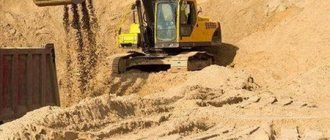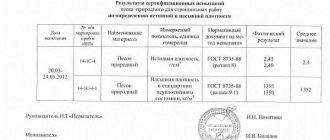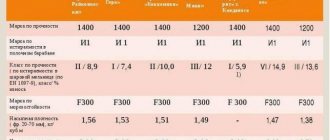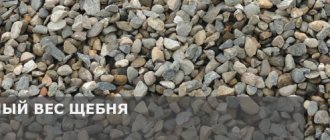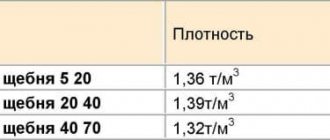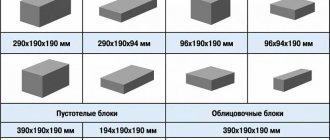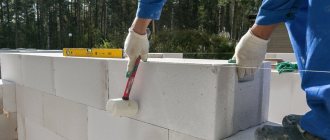Sand is a bulk substance consisting of grains of stone or mineral rocks. Domestic standards define the size of construction sand granules from 0.16 mm to 5.0 mm. Anything larger than 5 mm is gravel or crushed stone.
Particles smaller than 0.16 mm are practically not used in construction, since when combined with water they turn into dirt. Granules of this size are not used in filtration and drainage systems, since they no longer allow water to pass through.
Sand is obtained in two ways:
- Extraction from natural quarries and from the bottom of reservoirs - rivers and seas.
- By grinding and dispersing rocks, quartz and other minerals.
Since the bulk of sand is used in construction, density becomes one of the most important characteristics of this material. It depends on humidity, the percentage of clay and dust particles, the power of the compacting effect of water or vibration mechanisms, the curing time and the state of loosening.
The density of sand, unlike crushed stone, can, depending on humidity, vary within fairly wide limits. When dry sand is saturated with moisture, its density first decreases - the water increases the gaps between the grains of sand. Starting from 10 percent humidity, the density of sand begins to increase, since pure water fills all the voids and the mass per unit volume of the substance increases. From practice, everyone knows that a bucket with wet sand weighs more than with dry sand - the density of wet sand is greater.
Clay particles and lumps of clay increase the density of sand, which is one of the signs of clogging with these pollutants. Thus, the bulk density of sand with clay can reach 1800 kg/m³, while the material purified from it has an indicator of 1500 kg/m³.
Indicators of true and bulk density of sand are important for economic activity.
How to accurately calculate the required amount of sand
In order to accurately convert cubes of sand into tons or tons into cubes, it is necessary to know exactly the density of this material, provided that it is relatively stable in compaction and a given volume.
Accurate determination of the physical characteristics of sand is possible only in a laboratory; moreover, the humidity and compaction of sand constantly fluctuates depending on weather conditions and the method of its development, so an accurate mathematical calculation is practically impossible. At the same time, the high cost of laboratory research is unprofitable in relation to the error of averaged calculations. That is why in construction it is customary to carry out average calculations with a sand density of 1600 kg/m3 at a humidity of 5-7%. More than converting tons of sand into cubes, the problem is determining a sufficient amount of material, taking into account its compaction, because during the development, transportation and storage the volume of sand changes significantly. Therefore, when purchasing, a coefficient of 1.1-1.27 is usually introduced, taking into account these features, i.e. if according to calculations you need 10 m3, then it costs 11-13 m3, depending on the intended purpose of the material and the method of its storage.
If you want the real density of sand, taking into account weather and transport conditions, just call us at (343) 372-15-80 (81,82,83), and our managers will carry out all the necessary calculations for you.
| Why is the volumetric weight of different types of crushed stone different? |
| Calculation of the volume and weight of crushed stone/sand in the machine |
Choice
When purchasing material, it is important to correctly calculate the required amount of sand. For this:
- the given number is required * by 1.1−1.3. This is because volumes change during transport and storage;
- contact the manager to clarify the bulk density;
- carry out specific gravity calculations.
If possible, it is better to postpone the purchase. It is beneficial to do it when it is spring or summer outside.
The volumetric weight of sand for construction is a volumetric unit in the normal state of the material (where there are impurities and the material has accumulated a lot of moisture).
Volumetric and specific weight indicators may vary. Therefore, at the stage of real estate construction, it is important to pay attention to all errors.
The most important and necessary component when carrying out screed work is cement. By clicking on the link, you will find out what cement consumption is per 1 m2 of screed.
Among the various finishing materials, undoubtedly the most popular and popular is Rotband plaster. Here are all its technical characteristics.
Durable and very easy to install wall panels for the corridor will solve many of your problems. Wall panels for the corridor are not difficult, beautiful and stylish.
On average, the volumetric weight in 1 cubic meter is 1.5-1.8 tons. These indicators are taken into account in accordance with special GOST.
The specific gravity of alluvial type quartz sand (that which is mined from the bottom of the river) can range from 2.74 to 2.80 , these figures are average if there are no organic impurities.
Sand has the ability to retain heat and accumulate energy. This number is considered to be a witness to the thermal performance of the sand. The ability to heat up depends on chemical elements. They are also based on the structure and quantity of the material used, as well as its structure and physical characteristics.
Heat capacity indicators are also necessary at the stage of concreting walls.
Depending on the type, sand can have the following specific gravity values:
- wet based on quartz – 2.9 kJ/kg.
- extracted from the river bottom – 0.8 kJ/kg.
- extracted by mining – 0.84 kJ/kg.
- extracted from part of the world's oceans - 0.88 kJ/kg.
Why know how many cubes are in a ton of sand - specific gravity
Almost all building materials are either artificial or natural. Speaking about the last option, it consists of grains with a size of 0.16-5 mm, and its bulk density is in the range of 1300-1500 kn/m3.
Whatever type of sand you choose, you need to know that it has one very good property - it absorbs moisture, removing it from other finished products, while increasing its flowability. It is logical that if the volume changes, then the bulk density itself changes, which in turn depends on how the humidity changes.
If, for example, humidity fluctuates in the range of 3-10%, then this material differs from dry material in its density. It is worth understanding that a grain of sand, which is covered with a layer of water, increases in volume, and this leads to an increase in the density of the sand.
This suggests that when calculating construction work, it is worth taking this into account (bulk density) and knowing how the density changes as humidity increases. It is the level of sand quality that depends on its density.
The density of different types of sand, such as river, quarry or construction sand, will differ slightly from each other.
This is a very necessary characteristic, especially when it comes to professional construction, since this property affects the strength of the object and, accordingly, its service life.
The density of sand is already a known figure and you don’t need to count it, but in order to calculate the volume of sand in a tone, you need to determine its mass. The calculation is carried out using the formula m=V*p. Obviously, v is the volume of sand, and p is the density.
There are two types of sand density:
- Bulk.
- True.
True and bulk density
This value is influenced by some factors that are worth considering:
- the amount of impurities in the material itself (clay, dust, debris);
- immediate humidity level. A fairly humid factor, it is this that influences the density. If the humidity increases to 10%, then the density of the sand decreases, as different lumps form in it. But in such a situation the volume increases;
- sand particle size. Since sand consists of small grains, to take into account its density, you need to know the fraction of the material;
- You also need to take into account the type of sand, which depends on where the sand is mined.
For more information on determining sand density, watch the video:
Density
Sand GOST 8736 is a material that flows. The indicator under consideration is based on the dimensions of the air layers that are located between the main elements.
There are some types of body mass per unit volume:
- real;
- technical;
- bulk. It is determined by the ratio of the mass of the material used to the volume that it will occupy. Few take into account the emptiness, as well as the porosity of the material itself, for the final indicator;
- conditional or true indicators. This is the maximum limit of the density ratio that the material occupies, and the cavities N2 and O2 are not taken into account.
The true figure will always be higher than the real one. This value is essentially conditional or theoretical. From a practical point of view, its density is similar to bulk.
Density
For sand with different characteristics, it is allowed to use the following bulk density (tons per m3) :
- for dry extracted from the river - 1.4−1.65;
- for wet river - 1.7−1.8;
- for compacted river - 1.6;
- for fine-grained material extracted from quarries - 1.7−1.8;
- for a dry, mineral-based one of the crystalline varieties of silica—1.5;
- for ground, made from a mineral, one of the crystalline varieties of silica - 1.4;
- for a compacted mineral-based material, one of the crystalline varieties of silica-1.6−1.7;
- for material extracted by mining grade 500−1000 - 0.05−1;
- for material made from blast furnace, dump and granulated solid residue after smelting metal from ore - 0.06−2.2;
- for molding material of normal humidity according to GOST standards - 1.7;
- for material with dust impurities – 1.6−1.7;
- for material that was mined high in the mountains—1.5−1.6;
- for building material, normal humidity according to GOST standards - 1.5−1.7.
Depending on the degree of saturation of the sand with certain valuable minerals, several types of placers are distinguished.
According to the specific gravity, this material can be made from a heavy mineral (weight indicators greater than 2.9) and from a light mineral (weight indicators less than 2.9).
For more information on determining density, watch the video:
Effect of impurities and temperature on water weight
From a physics point of view, the specific gravity of the liquid is also important. The amount of the substance of interest that is placed in a volume (in 1 of its units) or, if translated into a scientific term - the mass of a unit of volume - is volumetric density or, to put it differently, specific gravity. This value is measured in kg/m3 or in tons/m3 or gp/cm3.
The table below clearly demonstrates the direct effect of temperature and organic impurities on weight. Thus, one cube of liquid in different states contains unequal specific gravity. The data was taken from the reference book of physical properties and materials.
| Name | Number of tons in 1 cube – weight of 1 m3, t/m3 | Number of kilograms in 1 m3 – mass of 1 m3, kg/m3 | Specific gravity, gp/cm3 |
| Water at room temperature at normal atmospheric pressure, m3 | 1 | 1000 | 1 |
| Hot water at normal atmospheric pressure, m3 | 0,98324 | 983,24 | 0,98324 |
| Sea water, m3 | 1,02 | 1020 | 1,02 |
| Water at 0 °C at normal atmospheric pressure, m3 | 0,999 | 999 | 0.999 |
Now you know the true weight of water in different states and under different conditions. And after some simple calculations, you can convert it into the required units of measurement.
Volumetric weight of dry quartz sand according to GOST
The volumetric weight of sand in 1 m3 is somewhere between 1500 and 2800 kilograms.
At the stage of use for work purposes, specialists should be interested in:
- specific gravity and volumetric weight of construction sand kg m3;
- particle strength;
- characteristics of its surface;
- grain size or particle shape;
- possible durability of the material, the mineral composition is also taken into account;
- expansion coefficient of volumetric as well as linear type;
- strength;
- how much the particles are worn;
- filtration coefficient;
- compaction coefficient.
When designing the composition of a building mixture, it is worth knowing:
- specific gravity of sand and volumetric bulk parameters of sand;
- the presence of voids and the ability to accumulate moisture.
Specific gravity
The specific gravity of sand kg m3 or specific mass indicators is an indicator that can be placed on a volumetric scale.
It is determined by the ratio of the material mass in dry form and the volumes that are handled.
In almost all calculations for sand, only volumes of 1 cubic meter are used.
How to determine how much a cube of sand weighs: material characteristics
Many owners of country houses try to calculate the weight of sand in one cube. This indicator is especially relevant for suburban construction, which involves such serious amounts of work as the construction of a building or the arrangement of a yard and local area. How much does 1 cubic meter of sand cost with delivery is one of the burning questions of any person who undertakes independent construction or is concerned about purchasing material for hired workers.
Depending on how many kilograms of sand are in a cube, the main proportions of the concrete mixture will be calculated. This point is very important, since an incorrect calculation will lead to disruption of the technology and serious consequences.
Sand is used for a wide range of construction work
Why is it so important to determine how many cubes of sand are in 1 ton
An indicator that reflects how many kilograms are in 1 cubic meter of sand can cause many difficulties if calculated incorrectly:
- violation of the concrete mixture recipe;
- incorrect consistency of the finished solution;
- loss of adhesive properties;
- low quality concrete;
- disturbances in the hardening process;
- reduction in concrete strength;
- premature destruction of a structure made of cement mortar.
For this reason, it is very important to determine not only how much sand is in 1 cube, but also what weight of material is contained in this volume
When calculating the required number of cubic meters of sand, its specific gravity is taken into account
An indicator that reflects, per 1 cubic meter, how many kg of sand is contained in a specified volume is called specific gravity or specific gravity. This measure, applicable to bulk materials, is in the range of 1500-2800 kg/m?. Accordingly, you can now estimate how many kg of sand are in a cube.
The value of the specific gravity of a material can be influenced by various factors, including:
- composition of minerals;
- grain composition;
- fraction size;
- humidity level;
- compaction percentage;
- impurities.
Compacting paving slabs using wet sand
Sand Density
Today, many are concerned about the cost of a cube of sand, but few people know that the final price is influenced by the characteristics of the material, one of which is density. Sand, like crushed stone, belongs to the category of bulk materials. The level of its density depends on the air layers that form between solid particles.
Sand density is:
- technological;
- real;
- bulk - represents the ratio of the specific gravity of sand to the volume occupied by this material. In this case, the volume includes not only solid sand particles, but also all the pores, as well as voids present in the embankment (taken as the basis for determining how many cubes of sand are in a bag or bucket);
- true or conditional - the value is considered as the limit of the ratio of the specific gravity of the material to the volume it occupies minus all the pores and voids present in the embankment.
The density of sand varies between 1.3-1.8 t/m?, and is equal to 1.3 t/m? for river sand, and 1.4 t/m? - for career.
The density of construction sand is from 1.3 to 1.8 tons per 1 cubic meter
Sand fraction size
How many cubes of material are in a bag of sand can be determined taking into account its grain composition. To do this, it is enough to sift the grains of sand using special sieves. As a result, you will be able to determine the level of gravel particles in the material that have certain dimensional data. Typically, the calculations use the particle size modulus of the material.
Table 1. Sand fineness modulus:
| Material type | Size of material fractions, mm |
| Small | 1,5-2 |
| Average | 2-2,5 |
| Large | more than 2.5 |
If you have fractions larger than 2.5 mm in size, most likely you are dealing with quarry or river sand; how much a cube of material weighs in this case will depend on water demand.
According to particle size, the material is divided into 2 classes:
- I – more than 1.5 mm;
- II – with any dimensional data.
The class of material and the size of its fractions determine how much 1 cubic meter of sand costs for construction work.
There are three sizes of sand fractions - fine, medium and coarse
Size index – large, medium and small
The size index indicates the grain material component. By sifting through professional devices, you can determine how much gravel, or rather its fractions, is contained in the material. Depending on the volumetric module it is divided into:
- large, with particle sizes greater than 0.0025 m. It can be extracted from quarries or rivers;
Large
- medium , with particle size from 2 to 2.5 mm;
Average
- small, with a particle size from 1 to 0.0025 m.
Small
Particle size affects the consumption of building materials and its ability to accumulate moisture.
Particle size
Based on its massiveness, it is divided into several groups:
- Class 1, which includes materials with particle sizes from 1.5 mm;
- Class 2, does not depend on dimensions and dimensions.
How to calculate weight?
The material is sold on wooden pallets. This way it can be laid more tightly, and loading and unloading operations can be carried out using a crane or lift. The permissible weight of a pallet of bricks, according to building codes, should not exceed 850 kg, taking into account the weight of the pallet itself (about 40 kg), although in reality it is usually larger. It is convenient to count the products on a pallet, since they are stacked in the form of a cube.
The weight of a cubic meter of an ordinary single solid brick is about 1800 kg; a pallet includes a slightly smaller volume, weighing up to 1000 kg. One cubic meter of one and a half material weighs about 869 kg; approximately the same volume fits on a pallet. The weight of a cubic meter of double brick reaches 1700 kg; about 1400 kg can be placed on a pallet. That is, the weight of one pallet of different products will not be the same.
It is impossible not to mention the so-called white brick; it is made from quartz sand and lime, which is why it is sold under the name silicate. In the 20th century it became very widespread. This material is much denser than the previous one and has even greater sound insulation. White brick is also not the same. A solid single sand-lime brick weighs about 4 kg, one-and-a-half up to 5 kg. It can also be hollow, its weight: single about 3 kg, one and a half almost 4 kg, double more than 5 kg. It can also be a facing brick, such a brick is also hollow, usually one and a half, less often double. The first weighs about 4 kg, the second almost 6 kg.
You can also calculate the approximate weight of a pallet of other types of sand-lime bricks. And, of course, the weight of 1 cubic meter of material is not equal to the weight of the pallet: a full-bodied single pallet will weigh about 1900 kg, a one-and-a-half pallet will weigh more than 1700 kg. The hollow single is already more than 1600 kg, the one-and-a-half is about one and a half tons, the double is about 1,300 kg. Facing sand-lime brick, which is made with voids, is somewhat lighter: one-and-a-half about 1400 kg, double about 1200 kg. But there are always discrepancies associated with some technological differences in products from different manufacturers.
Sometimes you need to know the mass of bricks when dismantling walls or even entire buildings, this question becomes relevant. A cubic meter of combat cannot be converted into pieces. So how much does a broken brick weigh? Volumetric weight (kilogram/m³) is used for calculations. The accepted norm for calculating the weight of bricks is 1800-1900 kg per cubic meter.
A summary table of brick weight is in the next video.
Let's block ads! (Why?)
Why do you need to know the weight of construction waste?
To calculate everything correctly, you need to know several key parameters: density of construction waste, weight, volume. The estimate documentation includes the costs of dismantling, loading and unloading, and transportation of construction waste to places of disposal or disposal. A separate column identifies the costs of its acceptance and processing by landfills and other accommodation facilities.
In this case, the unit of measurement used in estimate calculations is mass, indicated in tons.
Based on the information received, it is possible to plan transport logistics, determining the number of removal trips taking into account the carrying capacity of the vehicles, the distance to the landfill and other parameters, as well as calculating the number of garbage containers or bags for waste accumulation.
1m3 = 1.43t = 1430kg
* Data obtained according to laboratory studies, passports for 16 varieties (types) of sand, taken from 6 quarries. Conversion factor 1.43 - valid throughout the entire territory of St. Petersburg, and most of L.o.
To determine how many cubes there are in a ton of sand, you need to know its density. And it is equal to 1.43. Next, using the formula: V = m / p, where values: V - volume of sand, m3; m—body mass, t; p—constant 1.43; You can calculate the volume of sand depending on specific mass values.
Example 1. You have 0.3m3 of sand. How many kilograms is this? According to the formula: m = V * p, we calculate: 0.3 x 1.43 = 0.429 t x 1000 = 429 kg
Example 2. One cube of sand contains 28.6 bags, 50 kg each. Total: 1 m3 = 28.6 x 50 = 1,430 kg
Chemical and physical properties
Quartz has a crystalline structure. This structure gives this mineral and the sand obtained from it exceptional strength and resistance to acids and alkalis. Quartz sand is a very hard and refractory material; its chemical composition determines its fire safety and increased fire resistance. Sand obtained from quartz is inert to most chemicals and has dielectric properties.
Requirements for industrial quartz sand
According to the chemical composition, industrial quartz sand must have at least 95% silicon oxide content. The ratio of clay impurities should not exceed 1%. The presence of iron oxide is no more than 1%. The moisture content in dried sand should not be more than 10%.
Special requirements apply to glass grade sand. Depending on its chemical composition, it is divided into brands with the following letter designations:
- OOVS – especially responsible for high translucency;
- OBC – responsible for high translucency;
- BC – high translucency;
- C – translucent;
- B – colorless;
- PB – semi-white;
- PS – reduced translucency;
- T – dark green glass.
Quartz sand for the silicate industry is divided into classes:
- class A – silicon oxide content more than 70%;
- class B – not less than 60%;
- class C – not less than 50%.
Influencing factors
Good river sand is delivered to customers in a more or less standardized form. However, it still experiences a number of influences that directly affect the mass of a particular volume. It is quite obvious that the higher the humidity, the higher the density. More precisely, the so-called bulk density of the bulk substance depends on the degree of moisture. Experienced builders and delivery workers know well that storing sand outside in winter increases its severity by 10-15%.
The specific indicator depends on the amount of snow and ice that has formed on the stored sand
It is also necessary to pay attention to the grain size. This indicator, influencing the trading parameters of the material, is itself determined by the geological and climatic parameters of a particular deposit
It is customary to divide sand according to particle size into 3 main categories:
- small (no more than 1.5-2 mm);
- medium (from 2 to 2.5 mm);
- large (over 2.5 mm).
Sand raw materials from reservoirs have increased roundness. After all, grains of sand are affected by both water and friction. With mechanical action, the flakiness increases, which, however, affects to a greater extent not the weight, but the strength of the sand. For private buildings and small paths, flakiness can be ignored. But during large-scale construction it cannot be ignored.
The bulk density of sand is determined primarily by compaction. Shaking increases compaction. In the process of pouring from one container to another, during unloading it contracts. Accordingly, the compaction coefficient can vary from 1.1 to 1.3. But one more nuance must be taken into account - various impurities may be present in the sand; To take everything into account as accurately as possible, you need to buy sand on a warm, dry day.
Materials science distinguishes the following types of sand densities:
- real;
- technological;
- bulk;
- true (also conditional).
Bulk density is determined by dividing the weight of the raw material by its volume during the research process. In this case, any cavities and air-saturated spaces are taken into account. Conditional density denotes what the ratio of mass and volume of a substance is after its greatest practically usable state. But sand is loose, and therefore, under real operating conditions, it does not achieve the greatest compaction. To achieve this, professional presses are used.
The true density will definitely exceed all other parameters. In many cases she turns out to be twice their height
However, from a builder's point of view, only bulk density is of real importance.
The volumetric weight of sand is determined taking into account the particle size modulus or grain composition indicator. The measurement is carried out by sifting the source material through a sieve with heterogeneous cross-sections of passages. This method only seems primitive, but in fact it is quite accurate. It is easy to determine the content of all kinds of impurities in sand, primarily gravel.
Important: the cross-section of sand grains affects not only the mass, but also the so-called water demand
The typical grain size of river sand is normally 0.3-0.5 mm. The absence of various inclusions or their extremely limited quantity means that a cubic meter of sand from the river weighs more than sand raw materials from the quarry. When assessing humidity, one must understand that it affects both specific gravity and bulk density (albeit to a slightly lesser extent). Such information is quite enough to estimate the required amount of raw materials for various situations. For more detailed information, please contact qualified consultants.
Kinds
Varieties of sand are divided both according to the places of their formation and the method of extraction.
Nautical
It is mined using a nonmetallic method using hydraulic projectiles. The purified material is suitable for use for solving certain construction problems, for example, producing concrete compositions and ready-made fine mixtures. However, the extraction of sand of this type is a complex task, so mass production has not been established.
River
It has a high level of cleaning. The composition contains no clay impurities or foreign inclusions. The place of extraction of sedimentary rock is the river bottom in the channel. The particles of such sand are quite small (1.5-2.2 mm), oval, yellow or gray. Due to the absence of clay, the material is considered a very effective component for mixing building compositions.
Career
This sand contains less than 10% foreign inclusions. Its color is mainly yellow, but there are lighter or darker tones, depending on the additives. The grain is porous, slightly rough - these characteristics provide the required quality of adhesion to cement components. The density of the material is equal to the specific gravity. As for the degree of filtration, it is approximately 7 m (indicates the quality of water transmission). The minimum coefficient is 0.5 m3 per day (depending on the fraction and existing impurities).
The moisture content of quarry sand is about 7%. An increased background radioactivity is noted. Ideally, such sand does not contain more than 3% organic matter. Moreover, the amount of sulfides and sulfur is not more than 1%.
Artificial
The uneven location of places where natural sands are mined has led to the development of enterprises for the production of a similar artificial substitute, which is divided into classes depending on the chemical composition and feedstock, crushed to the required fraction.
Crushed. Artificial dry sand replacement is used in acid-resistant and decorative compositions.
Washed
It is extracted using a large volume of water and a special hydromechanical device - a decanter. The mass settles in water, and impurities are washed out. The material in question is fine-grained - its particles have a size of no more than 0.6 mm.
Washing technology makes it possible to obtain a mass of fine fractions without inclusions of clay and dust particles. This is a pure type of sand that cannot be replaced by anything in the production of building materials.
Sieved
The rock is processed with the assistance of special equipment. The bulk mass is sieved to remove foreign impurities. This sand is suitable as a component for mixing solutions. The sifted material turns out weightless and very soft. This type of quarry sand is inexpensive and suitable for construction.
Building
The most consumed and practically irreplaceable type of sand, which does not have its own special classification, but means a group of any varieties of this bulk material suitable for use in construction. In trade it is represented by several types. During construction, this sand has no equivalent analogues. It consists of rock particles with unsurpassed properties. Shell rock is also widely used in construction - a porous material made from compressed shells and natural minerals.
A description of sand types will be incomplete without information about visual indicators - fractions and color. Black sand is considered a rather rare variety of the fossil in question. The reason for the blackening lies in geological processes, when light components are washed out from dark hematites and other minerals.
When studying the classification of sand, it is important to take into account the construction type of bulk material that has certain properties. Among them it should be noted:
- environmental friendliness;
- fluidity;
- combustion resistance;
- durability;
- no rotting.
The material does not provoke allergic reactions and does not affect the indoor microclimate. It has excellent fluidity, which contributes to good void filling. When interacting with fire, it does not release toxic substances. This is a durable material with an unchanged structure. Construction sand has round grains, so the production of mortars requires a large volume of cement and constant mixing.
Basics of calculating sand tonnage in m3
When working with conversion from one value to another, you should remember that the fact how much a cube of sand weighs is influenced by two parameters:
- compaction and moisture content of the material;
- density of raw materials.
Fine-grained quarry sands contain many impurities that strongly compact the raw materials. In this case, the density of the material will be in the range of 1700-1800 kg/m3.
To determine how much a cube of sand weighs, you need to multiply the density of the raw material by the volume.
Coarse sand has a density in the range of 1400-1600 kg/m3. The mass of any bulk material is affected by its humidity. According to the standard, sand moisture content should be about 6-7%. If this figure varies within 20%, then the mass of the entire material will exceed the calculations by about 5 tons. And this is on the condition that the useful volume of an average dump truck is 12 m3.
So, figuring out how to convert cubic meters to tonnage wasn't that difficult. The main thing is to know several parameters.
Comments
Loading...
Similar materials
Home comfort How much does a cube of pine weigh depending on humidity?
There are situations in life when you are faced with seemingly simple questions, but you cannot give exact answers to them. During construction, for example, you may need to answer the question: how much does a cube weigh...
Home comfort How to calculate how much a bathroom renovation costs?
People strive for coziness and comfort, so renovating an apartment or house is very relevant today. As you know, this process is complex and quite labor-intensive. But some rooms require special attention. T…
Home comfort Determine how much a cube of concrete weighs
On numerous forums dedicated to repair and construction, new threads arise with surprising consistency, which address the question of how much a cube of concrete weighs. Although often, instead of a sensible answer, h...
Health How to calculate how many calories are in green tea
If you decide to lead a healthy lifestyle and even lose a few extra pounds, then you are probably interested in the calorie content of many foods. So, now you can find a lot of lookup tables, calculators that...
Home comfort How much does a board cube weigh: main characteristics
You can clearly see that the cut board in cross section has the shape of a regular rectangle. This fact distinguishes it from an uncut board
Thanks to such an important feature, it can be laid evenly in…
Characteristics
Quarry sand is a material that is of natural origin. This is due to the fact that it is extracted directly from the quarry. In most cases, the deposit of material is not located at a great depth under the soil layer.
Where and how to use quarry construction sand can be found in this
Taking into account the size of the space between the granules, the specific gravity can differ many times for different fractions of the same type of material. For example, the parameter under consideration for quarry sand with small granules will reach 1700-1800 kg/m3. For sand with medium and coarse grains, the specific gravity will be 1500-1600 kg/m3.
What is the cost of river sand, indicated in this
The next parameter is the density of the material in question. This value is equal to the specific gravity. In the field of construction, the concept of bulk density has been established for bulk products. In this case, we are talking about the density of the product in its uncompacted form.
The presented parameter can change its values under the influence of a variety of factors. For example, the level of humidity and mechanical influence greatly influence the parameter under consideration. The reason is that each particle is enveloped in a film of water, as a result of which the distance between the grains increases. By applying pressure, the density increases, reducing the space between the grains.
The density of the product is directly dependent on the quality composition. If it contains clay components in large quantities, then the density of the sand will be greater. In addition, the characteristic under consideration is influenced by the size of the grains, as well as its belonging to the fractions. The larger the fraction, the lower the density indicators.
If we consider the radioactivity of sand, it depends on the deposit of the material. Since it is extracted from mining, this product is characterized by an increased radioactive background. When constructing residential buildings and agricultural structures, it is necessary to use sand with the first class of environmental friendliness. When constructing road surfaces, it is necessary to use sand of classes 2 and 3.
The level of humidity depends on the mass of the material. The higher this parameter, the greater the weight. For sand extracted from a quarry, the moisture level should not exceed 5-7%. The amount of clay components and organic substances in the presented product should not be more than 3%, sulfites and sulfur - up to 1%.
How much does 1 cubic meter of sand weigh?
Home comfort How to calculate the volume of concrete - formula. How much does 1 cube of concrete weigh? How many cubes of concrete are needed for the foundation?
Concrete is an artificially made stone building material. You can make it yourself or buy ready-made reinforced concrete products from a factory, which reduces construction time.
Business How to calculate how many boards are in a cube?
Before we begin to calculate the cubic capacity of different types of boards and answer the question: “How many boards are in a cube?” — we should consider what the concept of “cubic meter of lumber” means, and what the pre...
Home comfort How to calculate how many square meters of building material are in one cube
During construction, the question often arises about how many square meters are in one cubic meter. This applies to many materials, which according to their parameters have three indicators: length, width, height. To obtain…
Home comfort How to calculate how many cubes are in a ton of asphalt?
Today, the transport network is one of the indicators of the level of economic development. High-quality road surfaces help increase freight traffic and reduce transportation costs, while increasing urban infrastructure…
Home comfort How to calculate how many tons of crushed stone in a cube
To carry out various construction works, even on a small scale, it is necessary to first calculate the amount of material required. Counting piece building materials will not be difficult. A little …
Cost and places of sale of products
Where to buy construction sand with delivery? In fact, the list of manufacturing companies engaged in the extraction and sale of sand is quite huge.
You can select the appropriate one from the advertisements posted on the websites; besides, almost every organization delivers goods to their destination.
- Finishing putty: types, application technique and characteristics. Tips for choosing the best composition
- Knauf plaster - characteristics, properties, types, applications and mixing of the mixture (105 photos)
- Do-it-yourself floor screed: types, construction technology and advice on choosing materials and tools. Video instructions and 110 photos from professionals
You can purchase goods in small quantities at construction supermarkets or markets. As a rule, the price of construction sand in large quantities is set per ton, in retail trade per kg.
In any case, whether you are planning to build a house or repair work, you cannot do without construction sand.
Number of cubic meters per ton
Before starting any construction, it is necessary to accurately calculate how much material will be needed for certain structures. This is a very important stage, which is why construction companies create entire departments to carry out such calculations and prepare estimates.
But you can carry out such calculations yourself if you decide to start building your own house. In order to ensure that you do not have excess material left or, on the contrary, do not have enough of it, you need to correctly calculate the weight of crushed stone in 1 m3 or in a ton, or convert m3 into tons.
To find this value, the services of special laboratories are usually used. To determine the bulk density of crushed stone, special tests are carried out with the help of which the density of the material is determined. How is it possible to convert a ton of crushed stone into a cube?
To convert a ton of crushed stone into cubic meters, the weight of the material should be divided by the bulk density. Let's look at an example. Let's say you ordered a dump truck with a load capacity of 20 tons. So, the weight of crushed stone is 20,000 kg, and its bulk density is 1500 kg/m3.
After carrying out the calculations, we get a volume that is equal to 13.3 cubic meters. Thus, a dump truck with a carrying capacity of 20 tons is capable of transporting 13.3 cubic meters of product.
Let us remind you that the crushed stone density of 1500 kg/m3 is not constant. It depends on the value of the fractions and varies from 1400 to 1600 kg/m3.
For a more convenient calculation, you can use a table that shows the weight of crushed stone 1 m3, taking into account the fraction value.
Table 1
| Fraction | Brand | Weight |
| 5 10 | M700 – 800 | 1.42 t/m3 or 1420 kg/m3 |
| 5 20 | M700 – 800 | 1.38 t/m3 or 1380 kg/m3 |
| 20 40 | M700 – 800 | 1.36 t/m3 or 1360 kg/m3 |
| 25 60 | M700 – 800 | 1.37 t/m3 or 1370 kg/m3 |
| 40 70 | M700 – 800 | 1.35 t/m3 or 1350 kg/m3 |
| 5 10 | M1200 | 1.44 t/m3 or 1440 kg/m3 |
| 5 20 | M1200 | 1.41 t/m3 or 1410 kg/m3 |
| 20 40 | M1200 | 1.37 t/m3 or 1370 kg/m3 |
| 25 60 | M1200 | 1.38 t/m3 or 1380 kg/m3 |
| 40 70 | M1200 | 1.36 t/m3 or 1360 kg/m3 |
table 2
| Fraction | Brand | Weight |
| 10 20 | M600 | 1.42 t/m3 or 1420 kg/m3 |
| 20 40 | M800 | 1.32 t/m3 or 1320 kg/m3 |
| 40 70 | M600 | 1.27 t/m3 or 1270 kg/m3 |
How to calculate the volume of a cube?
Formula for calculating the volume of a cube
- Through the length of the edge, the Volume (V) of a cube is equal to the product of its length times its width times its height. Because...
- Through the length of the diagonal of the face As we know, the faces of a cube are equal to each other and are a square, the side of which can be found through the length of the diagonal using the formula: a=d/√2.
Interesting materials:
Is it possible to grow cyclamen from seeds? On what day do bean seeds germinate? At what distance should you plant dill seeds? Which website is the best to buy seeds from? Low-growing asters growing from seeds when to plant? Do I need to cover the seeds with film? Do I need to wash the seeds after soaking them in Fitosporin? Do I need to germinate zucchini seeds before planting? Do I need to germinate pepper seeds before planting? Do I need to germinate pepper seeds?
Is it possible to accurately calculate sand using a calculator?
Of course, it is difficult to calculate the exact volume of sand per ton on a calculator, since for this you need to know the characteristics described above. But in order to know these numbers, it is necessary to conduct laboratory studies, for this you need to have exact numbers, and not those that we see in the tables (rounded).
To make the task easier for the builders, it was decided to take approximate figures for calculation:
- humidity – 7%;
- density – 1600 kg/m3.
Of course, there will be a small error in the calculation, but it is more cost-effective than the decision to conduct laboratory tests. The volume of sand is calculated approximately. But in order to get clearer data, it is worth taking 1-3 cubic meters more.
This is necessary to take into account the losses that occur during transportation - compaction, dissipation.
How to convert kg to m3?
Converting kilograms to m3 is quite simple. It is enough to divide the mass by the density of the element.
Interesting materials:
What happens if you eat too much meat? What happens if you compress the air too much? What happens if you put Slime in the refrigerator? What happens if the ball joint breaks? What happens if you mix rye and wheat flour? What happens if you mix blue and purple? What happens if you mix blue and purple? What happens if you cut down trees? What happens if you wash synthetics at 90 degrees? What happens if you boil a penguin egg?
Calculation rules
Conversion from cubic meters to kilograms, and vice versa, is made based on accurate data on all of the above factors. Such information can only be obtained through laboratory work. The procedure is expensive, the values require constant monitoring of measurements. Therefore, it was decided not to weigh, but to measure the mixtures in cubic meters.
Conversion to weight
The mass of the cube is calculated by the formula: m = V*p. This is the product of volume and density. The volume is known, it is 1 m3. Density is found in reference tables. For example, let’s calculate the specific gravity of a building molding material of 0.2 m3, the particles of which, according to GOST 2138 - 91, have a density of 1710 kg: m = 0.2 * 1710 = 342 kg/m3.
The weight of commonly used types of construction sand per 1 m3 is summarized in the table:
| Name | Specific gravity ( kg ) |
| Construction dry loose compacted wet wet compacted | 1500 1440 1680 1920 2545 |
| Molding | 1710 |
| River washed compacted | 1630 1500 1590 |
| Quartz (compacted same) Dry | 1650 1500 |
| Nautical | 1620 |
| Career | 1500 |
| Dusty compacted water-saturated | 1675 1930 2000 |
These are reference data that take into account the natural moisture content of 6 - 7% of the total mass. When calculating the required quantity, in order to find out how many kg of sand contains 1 cubic meter, it is advisable to use coefficients of 1.1 - 1.27. For example, if you need 5 cubic meters, then it is worth purchasing 5.5 - 6.4 m3.
Machine capacity
How many cubic meters in a KAMAZ dump truck or any other vehicle is calculated based on the truck’s carrying capacity. The equipment has different body capacities - from 6 to 50 tons. Calculations again depend on knowing the weight of the material. A few more examples, now based on the average density:
- 4 * 1600 = 6400;
- 6 * 1600 = 9600;
- 8 * 1600 = 12800.
The resulting figures are the weight of bulk raw materials for 4, 6 and 8 m3, respectively, presented in kilograms. The result is divided by 1000 to obtain the value in tons and is determined by the capacity of the machine. The minimum capacity of a ZIL is 6 tons, which is no longer suitable for any of the presented volumes. We need machines with a carrying capacity of 8 tons or more.
Focus on Density
It is important to take this indicator into account when choosing a specific type of sand mixture to determine the means of its transportation. A ten-ton car with a body volume of 6 cubic meters is capable of transporting 8.3 m3 of sand with a density of 1650 kg: 6 * 1650 = 9.9
But if the particle compaction exceeds this level, the equipment will not cope: 6 * 1800 = 10.8 tons.
How many cubic meters are in a ton is an important question when loading a car. It must be understood that the value always corresponds to the specific gravity. The relationship of these parameters gives approximate figures for the sand capacity of various loaders. Some equipment has serious restrictions on body volume, which does not allow it to be used to its full potential. With a humidity of 5 – 7% and a density of 1600 m3, it is possible to transport:
- in ten-ton vehicles - up to 8.5 cubic meters of mixture;
- 17 t – 10 m3;
- 31 tons – 20 cubic meters;
- 50 t – 25 m3.
A similar calculation can be made for any container. For example, in a 10 liter bucket with standard compaction and moisture content, you get 0.008 m3 or 8 kg. Accordingly, a 50 kg bag of sand will weigh 31.2 kg. Such calculations should be applied directly when mixing concrete in order to obtain a high-quality structure.
Varieties
There are a sufficient number of varieties of sand. Each of them has found its application in everyday life and construction. Below are the most common types of sand.
River
Outwardly, it is a bulk material, not ore.
The advantage of it is that it does not contain: clay, dust, salt, pebbles, and so on.
River
This type of sand is extracted in two ways - equator draglines and hydromechanized methods. River sand can be easily distinguished from others by its appearance. It can be white, yellow, or with a gray tint. Sand GOST 8736 is used in everyday life and construction.
If we talk about construction, it is used in the manufacture of reinforced concrete structures, as well as in the manufacture of paving slabs, road slabs, and so on. Characteristics: density – 1.5 kg/m3, sand humidity – 4%, specific gravity – 2.65 g/cm3;
Quartz
Quartz sand is a special bulk material that consists of small granules with a diameter of 0.05-3 mm.
Quartz
It is the impurities that give the sand a certain shade; if we talk about pure quartz sand, it is milky white. It is used in many areas: sandblasting, glass making, concrete and other materials.
Due to its good characteristics, such sand can be painted in any color, which helps to create decorative plaster. Characteristics: humidity less than 10%, clay content 1%;
Career
At its core, quarry sand is an ore-like, granular, bulk material. It contains particles ranging in size from 0.7-5 mm. There are 3 main ways to obtain this type of sand: sifting, washing, open method.
Career
This type of sand is used in all foundation work and road construction work. Sand characteristics: fineness modulus 0.7-5 mm, impurity content 10%;
Nautical
It is a non-metallic bulk material. It is easy to find, on the seabed.
Nautical
It has a wide range of applications, ranging from banal construction to the production of various dry mixtures. But unfortunately, this type of sand is quite rare, since it is not always possible or convenient to extract it;
Artificial
Since the above types of sand are natural (except quartz), artificial sand can also be noted.
Artificial
Before choosing the right sand, you need to know all its characteristics and correctly calculate the volume of sand using rules and formulas. The main characteristics of sand include:
- dimensions, size indicator;
- radioactivity;
- specific gravity;
- a direct indicator of the volume of bulk mass;
- the amount of impurities in the sand;
- filtration coefficient;
- compaction coefficient;
- density.
Clay content in lumps
Clay is a plastic substance characterized by viscosity.
In sand it should be no more than 0.5% of the total mass. To determine a specific indicator, a sample of the material is moistened with water and then probed with a needle. Clay, as a rule, has low strength, so it is easy to determine tactilely (by touch). After this, the ratio of the amount of clay to the amount of sand is compared. Clay is easily washed out with water, but dry sifting cannot get rid of it. In addition, once it gets into any mortar, it remains in it forever. The presence of lumps of clay in concrete reduces its water resistance, which is unacceptable for hydraulic structures, as well as for underwater structures.
Varieties of natural sand
Natural and artificial sand is increasingly found on store shelves today.
River
The one that is mined from the river bottom. It stands out for its cleanliness indicators. May have a yellowish or grayish tint.
River
Particle dimensions reach 0.3 to 0.5 mm. It is used at the stage of mixing mixtures for construction, as well as solutions during the installation of drainages. It is considered the most used and popular type.
Quarry (dusty)
Dusty is mined using the classical method. Its shade is brownish or yellowish. The material contains dust-like impurities and small pebbles.
Career
In its purified and classic form, quarry sand is used for thick lime mortar and a complex of construction works related to the exterior and interior decoration of buildings; a cement screed is created on its basis.
It is extracted from the seabed and is characterized by improved quality.
Nautical
